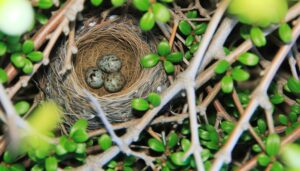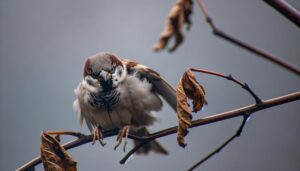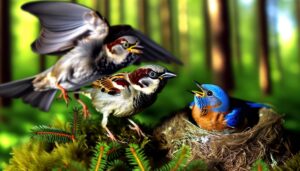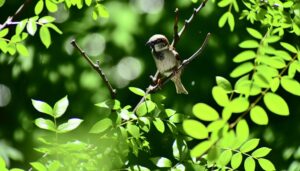Why Can’t House Sparrow Fly?
A house sparrow's inability to fly can stem from wing fractures, muscle strains, or ligament tears, all of which impair its flight mechanics. Respiratory infections and parasitic infestations diminish flight endurance by affecting energy levels and oxygen utilization.
Genetic mutations can lead to underdeveloped musculature and suboptimal feather structure, further compromising flight. Environmental pollutants, habitat loss, and predator threats also play a role by reducing mobility and access to food sources.
Timely rehabilitation involving medical intervention, proper diet, and controlled reintroduction to flight is essential for recovery. To gain a deeper understanding, further exploration of these factors is recommended.
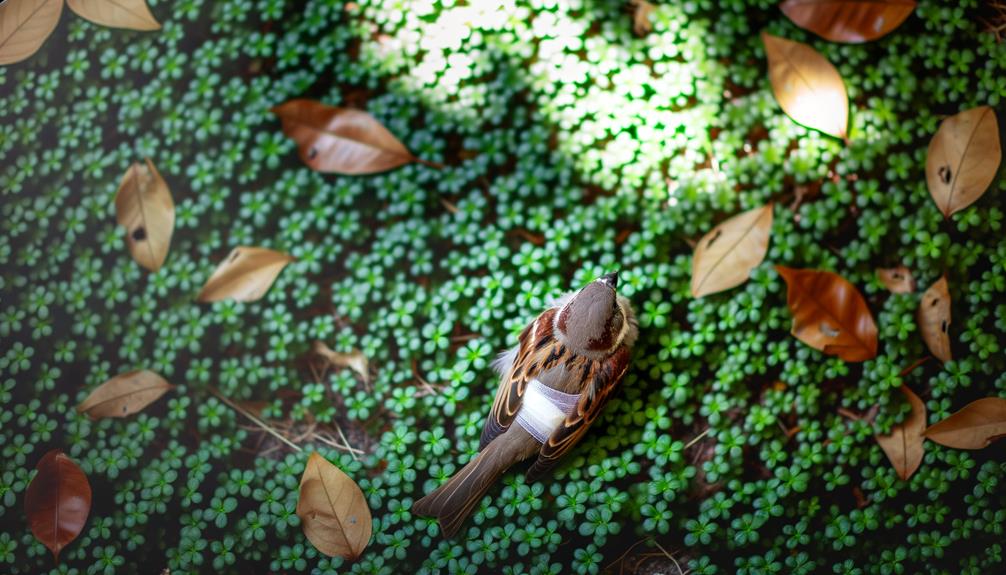
Key Takeaways
- Wing fractures are a common reason for flight impairment in house sparrows and require immediate medical attention.
- Respiratory infections can lead to lethargy and reduced flight endurance in house sparrows.
- Genetic mutations affecting muscle function and feather structure can compromise a house sparrow's ability to fly.
- Pollution and habitat destruction significantly reduce mobility and access to essential resources for house sparrows.
- Stress from captivity can lead to muscle atrophy and impaired flight capabilities in house sparrows.
Common Injuries
Common injuries in house sparrows (Passer domesticus) often include wing fractures, soft tissue damage, and beak malformations.
Wing fractures, typically resulting from collisions or predator attacks, impair flight capabilities and require careful intervention for proper healing.
Soft tissue damage, encompassing muscle strains and ligament tears, can arise from entanglement or falls, necessitating precise evaluation to ensure recovery without long-term deficits.
Beak malformations, caused by genetic anomalies or trauma, impact feeding efficiency and social interactions.
Observational analysis reveals that these injuries significantly hinder survival by reducing mobility and access to food.
Understanding the nature and frequency of these injuries aids in devising effective rehabilitation strategies, emphasizing the importance of timely medical intervention for these widespread urban dwellers.
Impact of Illness
Illnesses in house sparrows, ranging from respiratory infections to parasitic infestations, can severely compromise their physiological functions and overall survival. The impact of these maladies is multifaceted, affecting their ability to perform essential activities such as foraging and flying.
Observational analysis reveals the following specific impacts:
- Respiratory Infections: These impair oxygen intake, leading to lethargy and reduced flight endurance.
- Parasitic Infestations: External parasites, like mites, cause skin irritation and feather damage, hindering flight.
- Avian Malaria: This blood parasite reduces hemoglobin levels, thereby decreasing the oxygen-carrying capacity of the blood.
- Nutritional Deficiencies: Resulting from illness, these weaken muscle function, essential for sustained flight.
Understanding these impacts is crucial for devising effective conservation strategies.
Genetic Factors
Genetic factors play a significant role in the flight ability of house sparrows. This influence ranges from muscle development to feather structure. Genes determine the composition and density of flight muscles, particularly the pectoralis major and supracoracoideus, crucial for lift generation. Mutations or anomalies in these genes can compromise muscle functionality.
Additionally, genetic coding affects feather morphology, such as the robustness and arrangement of primary and secondary feathers essential for aerodynamic efficiency. Observational studies show that sparrows with genetic mutations often display asymmetrical or underdeveloped feathers, resulting in impaired flight.
Moreover, the genetic predisposition towards certain metabolic rates can impact energy availability, affecting sustained flight capability and overall aerial performance.
Environmental Hazards
Environmental hazards notably influence the declining flight capabilities in house sparrows, primarily through the impacts of pollution and habitat loss. Elevated levels of air and soil pollutants have been observed to impair respiratory and physiological functions in these birds, hindering their ability to sustain flight.
Concurrently, urbanization and deforestation contribute to the fragmentation and degradation of habitats, reducing the availability of essential resources for survival and mobility.
Pollution Impact on Sparrows
Exposure to various pollutants has been observed to impair the flight capabilities of house sparrows, potentially due to the detrimental effects on their respiratory and muscular systems. Empirical studies have identified several key pollutants affecting these birds:
- Particulate Matter (PM2.5): Fine particles can infiltrate the respiratory system, causing inflammation and reduced oxygen uptake.
- Heavy Metals: Elements such as lead and mercury accumulate in tissues, disrupting muscle function and neurological processes.
- Pesticides: Chemicals like organophosphates inhibit enzyme activity essential for muscle contraction and flight endurance.
- Airborne Toxins: Compounds such as ozone and sulfur dioxide can lead to oxidative stress, damaging cells and tissues essential for sustained flight.
These pollutants collectively compromise the physiological health necessary for effective avian flight.
Habitat Loss Consequences
How does habitat loss worsen the challenges faced by house sparrows in maintaining their populations? Habitat loss impacts the house sparrows' ability to locate food, shelter, and breeding sites, impairing their survival and reproduction rates. Urbanization and agricultural expansion lead to the destruction of natural habitats, causing a decline in insect populations, a primary food source for sparrow nestlings. Additionally, the loss of hedgerows and old buildings reduces available nesting sites.
| Habitat Component | Consequence of Loss |
|---|---|
| Food Sources | Decreased insect availability |
| Nesting Sites | Reduced shelter and breeding locations |
| Vegetative Cover | Increased exposure to predators |
| Water Sources | Limited access to essential hydration |
These changes collectively contribute to the declining populations of house sparrows, emphasizing the critical need for habitat conservation.
Predatory Threats
Predatory threats to house sparrows, including avian predators such as hawks and mammals like domestic cats, greatly impact their survival rates, particularly when these birds are incapacitated and unable to fly. These threats are exacerbated by the sparrows' limited ability to evade, leading to increased vulnerability.
Observational analysis highlights several key predatory pressures:
- Raptor Attacks: Hawks and falcons exploit open spaces where sparrows seek food.
- Feline Predation: Domestic cats account for significant sparrow mortality in urban areas.
- Nocturnal Predators: Owls and other night-time hunters pose threats during resting periods.
- Human Activity: Increased human settlements disrupt natural predator-prey dynamics, often leading to higher predation rates.
Understanding these factors is essential for devising effective conservation strategies.
Nutritional Deficiencies
While predatory threats greatly impact the survival of house sparrows, nutritional deficiencies further exacerbate their vulnerability by weakening their physical condition and impairing their ability to escape predators.
Deficiencies in essential nutrients such as proteins, vitamins, and minerals can lead to compromised muscle function and reduced energy levels. Observational data indicate that malnourished sparrows exhibit diminished feather quality, leading to impaired flight mechanics.
Vitamin A deficiency, specifically, can result in weakened immune responses, increasing susceptibility to infections. Additionally, a lack of calcium impedes proper bone development, making young sparrows particularly prone to skeletal deformities.
These deficiencies cumulatively hinder their ability to forage effectively, further perpetuating the cycle of malnutrition and increasing mortality rates within their populations.
Human Interference
Human interference has greatly affected the house sparrow's ability to fly through habitat destruction, which restricts their access to nesting sites and essential food resources.
Moreover, alterations in feeding habits, influenced by human-provided food sources, result in nutritional imbalances that impede proper development and flight capabilities.
Additionally, the stress induced by captivity and close human proximity can cause physiological and behavioral changes harmful to their flight proficiency.
Habitat Destruction Impact
The degradation of natural habitats due to urbanization and agricultural expansion has disrupted the nesting and foraging environments of the house sparrow, *Passer domesticus*. This anthropogenic impact is evident in several critical ways:
- Loss of Vegetation: Urban sprawl removes trees and shrubs essential for nesting and food sources.
- Pollution: Increased air and noise pollution directly affect sparrow health and reproductive success.
- Monoculture Practices: Large-scale agricultural practices eliminate diverse habitats, reducing food availability and shelter.
- Building Structures: Modern architecture lacks the crevices and cavities that sparrows traditionally use for nesting.
These factors collectively contribute to the declining house sparrow populations, underscoring the need for conservation strategies that mitigate habitat destruction.
Feeding Habits Alteration
Anthropogenic influences have greatly altered the feeding habits of the house sparrow, impacting their nutritional intake and overall health.
Urbanization has led to the proliferation of anthropogenic food sources, such as processed foods and waste, which are less nutritionally balanced compared to their natural diet of seeds and insects.
Observational studies indicate a shift towards higher carbohydrate consumption, resulting in metabolic disorders and reduced reproductive success. Moreover, reliance on human-provided food often leads to increased competition and aggression among sparrows.
This dietary shift not only affects individual sparrows but also has broader ecological implications, potentially disrupting local ecosystems. Continuous monitoring and intervention are essential to mitigate these adverse effects and support the conservation of house sparrows.
Stress From Captivity
Captivity-induced stress serves as a pivotal factor adversely affecting the physiological and behavioral health of house sparrows. The confined environment limits their natural behaviors, leading to a cascade of stress-related issues.
Observational studies have identified the following detrimental effects:
- Altered Corticosterone Levels: Elevated stress hormones disrupt metabolic and immune functions.
- Feather Loss and Damage: Stress-induced behaviors such as over-preening cause physical harm.
- Reduced Reproductive Success: High stress impairs mating behaviors and reduces offspring viability.
- Impaired Flight Capability: Muscle atrophy and lack of exercise lead to weakened flight muscles.
Understanding these stressors is essential for developing humane captivity practices that mitigate adverse effects, ensuring the well-being of house sparrows in controlled environments.
Rehabilitation Techniques
Implementing effective rehabilitation techniques is vital for restoring the flight capabilities of an injured house sparrow. Initial assessment should include a thorough physical examination to identify fractures or soft tissue injuries. Immobilization of fractures using avian splints and bandages is essential for proper bone healing.
Physiotherapy, including passive range-of-motion exercises, helps maintain muscle integrity and joint flexibility. Nutritional support tailored to promote bone and muscle repair is recommended, typically including a high-protein diet supplemented with calcium and vitamins.
Gradual reintroduction to flight should occur in a controlled environment, utilizing aviaries with incremental height adjustments to monitor progress. Continuous observational analysis is required to adapt rehabilitation strategies, ensuring the house sparrow regains full functional flight capability.
Conclusion
The inability of the house sparrow to fly results from a confluence of factors. These include common injuries, illnesses, genetic anomalies, environmental hazards, predatory threats, nutritional deficiencies, and human interference. Each factor disrupts the delicate balance required for flight.
Rehabilitation techniques offer some hope, yet prevention remains crucial. As the adage goes, 'An ounce of prevention is worth a pound of cure,' emphasizing the importance of addressing these multifaceted issues to guarantee the well-being and survival of the species.

